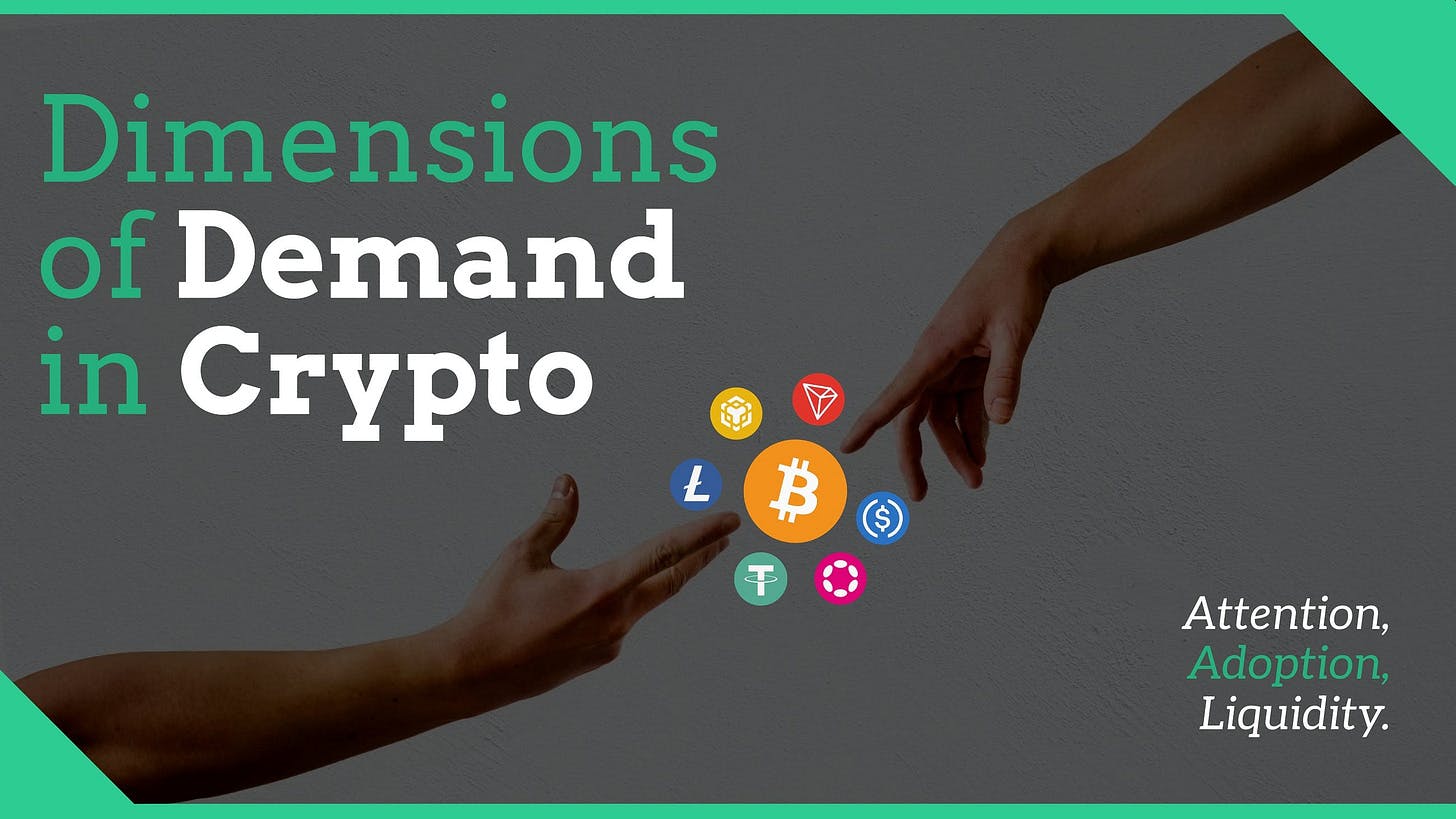Do you want to be in control of your finances or what?
Do you want to have the freedom to access you money wherever, whenever you need it?
Awesome!
Have you heard about Dog Wif Nail Polish; its a new memecoin on solana…
There is a single economic law that governs all markets:
Supply Vs Demand.
Supply in crypto is superabundant.
Fungible, Non-fungible, Stablecoin, Governance, Meme, Proof-of-Work, Proof-of-Stake, and so on; there is no shortage of new tokens spawning on a daily basis.
Just to put things in perspective, in 2017, there were roughly ~10,000 crypto assets. As of February 2025, there are over 11,500,000 and their growth only seems to be accelerating.
When supply outpaces demand, attention gets diverted, and liquidity gets spread unevenly, making for thin order books, causing prices to experience extreme sensitivity to selling pressure, which ends up resulting in aggressive downside movements (usually permanent ones).
When demand outpaces supply and maintains it over the course of time, we get Bitcoin.
By coupling careful economic design that takes proper consideration of supply dynamics with powerful, maximally simple technology that is philosophically aligned with society, a loyal community is bred, which kicks the flywheel effect of liquidity, begetting liquidity, and real demand consolidates around genuine assets.
There is no magic trick; the single factor that separates quality and ultimately dictates success is demand. Period.
As straightforward as it may seem on the surface, demand is actually a multi-dimensional principle with layers of dependencies and degrees of subtle nuances.
In other words, there are levels to this thing.
Demand Dominos
Demand tends to move uniformly throughout assets in relation to the most fundamental primitives associated with a project/product/economy.
There are two types of demand primitives: direct and indirect.
Direct relates to demand that arises from within a narrow niche sector. This can include things such as the desire to use an application, which translates to demand to own the application’s token, which in turn translates to demand to access the network it is built on, which translates to demand for the network’s token.
Indirect demand relates to demand that arises from independent macro forces such as money printing, interest rates, sovereign policies, and political regimes.
Both types of drivers are also reliant upon one another.
Things like monetary policies will impact the state of free-flowing/excess capital in the hands of the population, which will determine the public’s risk appetite, which indicates the types of assets likely to attract capital. Inversely, as higher-risk assets begin to rise without fundamental changes in available public capital, that indicates sophisticated market participants are expecting that capital will soon arrive in the hands of average retail and are front-running them.
As it pertains to crypto the ultimate levers of demand are rooted in the simplest of habits of human nature; the pursuit of pleasure and avoidance of pain… Both of which are triggered by narratives.
The overarching giganarrative applicable to both levers is Sovereignty. The protection from and opposition to government.
The overarching narrative on pursuing pleasure is perfectly Lambos, Rolexes, luxury trips, attention from attractive individuals, and recognition from friends and family. The desire to be right and profit from it. We call this gambling.
The overarching giganarrative on the avoidance of pain refers to the avoidance of FOMO. Watching other people make life-changing money elicits the desire to not be thought of as a fool and be left sidelined. We call this capitulation (losing integrity with one’s self and top-blasting the entire portfolio).
Who’s Driving?
To understand how to drive demand, we need to first understand how demand looks by identifying where it is coming from. Since the metric of demand is predominately expressed as buying/selling pressure and liquidity, the correct frame for identifying the source/origin of demand is to ask the question of WHO.
For the sake of keeping things simple, the who exists across three general categories:
Builders
These include individual developers tinkering around building tools, companies building real-world revenue-generating products, hackers looking for cracks to subvert systems, content creators writing epochs to spread the message, small teams in garages whipping up DEXs, bridges, and all sorts of other smart contracts.
Retail
The supermajority. The reply guys and KOLs on crypto Twitter. The memecoin investooors, NFT connoisseurs, speculating apes, and 100x degen gamblers. Also commonly referred to as the “bag-holders” or “Exit liquidity.” The speculators looking to bolster returns, escape the matrix, and scratch the itch of belonging to a community.
Institutions
These are the corporations diversifying their balance sheets with cryptocurrencies, Enterprises deploying tokenized debt obligations, and Governments turning volcanos into Bitcoin mining rigs.
Here, we omit the multitude of interim participants, including market makers, exchanges, service providers such as node infra and cloud servers, and others.
Demanding Demand
So then HOW is demand driven in crypto?
Obviously, by propping up a memecoin with insider liquidity, getting an influential person’s endorsement, and spamming replies with toxic “community” bot techniques….
Jokes aside, demand in crypto is driven the same way it is in any other area of life. Marketing.
We are not going to dive too deep into the moral implications of marketing, but we will just highlight that marketing is, by virtue of its nature, designed to manipulate emotions.
In an effort to prey on human nature, it boils down to choosing a method (attracting or forcing).
Attracting is the slow-grind method of organically building good products and communities. These take very long periods of time to build trust but create everlasting impacts and, at some point in time, become reflexive, self-sustaining super systems.
Forcing is using sleazy tactics to create a fake illusion that something is more valuable than it is. These are cheap, short-lived, and highly destructive methods that would best be understood through a DYOR looking at the cases of Argentina’s Memecoin and flipping through the countless stories of pumpfun.
Regardless of which marketing method drives the demand, it is important to the nature of the demand itself; here, we are talking about the form factors that measure adoption.
Measuring Demand
The most common, and incorrect, way to gauge adoption is by price. This slightly better way is through liquidity. Liquidity is the cornerstone of financial markets and the single most important metric when evaluating the economic well-being of an asset/asset class. Aka the desire to own [buying pressure], and the desire not to let go of [selling pressure].
When the price of crypto is moving up, it creates a visceral psychological loop in people’s minds that the crypto must be valuable, and it becomes a self-fulfilling prophecy of price growth. The inverse applies to price depreciation; when the number goes down, people assume the project is no longer in demand.
While there is valuable truth to this, it is not the entirety of the picture.
As a technology-first, pseudo-economic innovation, demand in crypto is much more complex with vectors in finance and technology. A non-exhaustive list is as follows:
-
MAU (Months Active Users)
-
DAU (Daily Active Users)
-
Total # of on-chain addresses
-
Total # of Smart contracts
-
Total # of Transactions
-
Total # of developers
-
Hashrate
of miners
-
Amount of tokens staked
of Nodes
-
On-Chain Volume
-
TVL (Total Value Locked)
The list and the amount of ways to interpret the according data is tremendous; the challenge that has yet to be adequately overcome is understanding how much of this demand is truly organic and synthesizing it with other drivers to genuinely grasp the state of a project.
Demanding the Why
Regardless of what it is that ultimately drives demand, the most important question to understand of all to always be asking is “Why”.
As difficult as it may be at times to ignore the external noise, give yourself the right to intellectually explore the underlying substrate by diving deep into the logical reasoning.
Why do I want to buy this?
Why do other people see value in this?
Why would somebody want to sell it?
Why would somebody want to own it?
Why does somebody think that other people want it?
Why would a project want to build on this network?
Why wouldn’t they build on another network?
Understandably, this is a steep slope as it gets even more difficult to sometimes dismiss your own biases and not get drawn down into a recursive loophole of questioning that causes decision overwhelm called “analysis by paralysis”.
Just understand that when you can control your impulses and genuinely explore the deepest, darkest corners through the question of why, without emotional attachment, you will at some point reach a point of final decision.
Being early is not always better,
It’s not about being right,
At the end of the day what matters is winning; and winning happens when you are willing to be wrong for the sake of being profitable.
Now let’s go out there and demand greatness 💫
See you on the other side Anon 🥂












